Design of an Emergency Energy System for a City Assisted by Renewable Energy, Case Study: Latakia, Syria
Abstract
:1. Introduction
2. Methodology
- 1.
- Energy shortage (electricity): We can consider 6 emergency levels according to the electricity cut off hours per day as shown in Table 1.
- 2.
- Migration: where in case of war or natural disasters, people migrate to other safe cities or areas and this causes an increase in residential energy consumption. We will consider 4 emergency levels according to the population increase percentage as Table 2 shows:
- : emergency energy.
- : total energy demand for the city in 1 year.
- : the percentage of expected energy demand for the next 2 years.
- : residential energy demand in the city.
- Power plants: if there is a power plant close to the city and the fuel supply for this plant is secure and stable.
- Installed renewable sources: if any renewable sources are installed in city and the expected energy can be produced from them.
- Uninstalled renewable energy: the cheapest and most available renewable energy sources in the city which could be shared to solve the energy shortage problem.
- Portable generators energy: these generators can share the load with the previous sources whenever energy produced from renewable sources can-not be expected or is not stable, as we have to use alternative stable sources of electricity when renewable energy sources supply a city alone. These portable generators could be such as are used for industrial and commercial activities inside and outside the city and when any unexpected situation arises, they can be moved to residential areas where special rooms and filters should be used to reduce the noise and pollution inevitable with them.
- : energy supplied from the power plant in one year (known).
- : energy supplied from installed renewable sources in one year (known).
- : expected energy produced from renewable sources which can be installed in one year (unknown).
- : expected energy produced from generators which can be installed in one year (unknown).
- Stable sources: which include power plants and portable generators can give stable power for all day and which we can describe in the following Equation (5):
- Unstable sources: which include the installed and expected installed renewable sources; such sources are not stable sources and are related to the weather in general and we can describe them as in the following Equation (6):
3. Case Study: Latakia City, Syria
3.1. The Effects of the War on Syria
3.1.1. The Social Sector (Especially the Family)
3.1.2. The Educational Sector
3.1.3. The Economic Sector
3.1.4. The Security Sector
3.1.5. The Service Sector
3.1.6. The Demographic Sector
3.2. An Overview of the Electricity System and Energy Sources in Latakia before the War
3.3. The Energy Shortage in Latakia during the War
3.3.1. Rationing Hours
3.3.2. Peak Power Demand
3.3.3. Peak Power Demand
3.3.4. Energy Resources
3.4. Causes of the Energy Shortage
- The appearance of ISIS in Syria has made people abandon their houses and go to safe areas and Latakia city is one of the safest cities in Syria as we mentioned before. And this has caused an increase in the population of Latakia city as shown in Table 3 and Figure 8 according to estimates, there being no formal statistics for the population. The numbers and percentages shown in the table relate to the population change only in the city centre of Latakia because most of the migrants live in the centre of the city in its various neighbourhoods. The change in the percentage in 2016 was a result of the liberation of Aleppo and Homs cities from radical Islamic groups, which contributed to the return of people from those cities to their homes.
- Significant decreases in oil and gas production were because ISIS captured most oil and gas wells in Homs and Deir Alzor as shown in Figure 9.
- The destruction of power plants and transmission lines by ISIS and other “terrorists groups” such as in Homs, Aleppo and Hama reduced the ability to generate energy and to transmit it between governates. Figure 9 shows the power plants in Syria.
3.5. The Current Solutions to the Shortage
- 1.
- Diesel and gasoline generators: with different power capacities from 1 kW up to over 500 kW. Figure 10 shows the number of generators in use from 2011 till 2016 where a rapid increase can be seen during the period 2011 to 2014 because of the big increase of population in this period due to migration as mentioned before. Also, we can notice that the highest increase where in the generators with small capacities due to the daily life needs of families such as lighting or some electronic devices.
- E: The generated energy for each year.
- : The average power for each group of generators.
- : The number of generators for each group.
- : The number of rationing hours for each year.
- 365: The number of days in a year.
- 2.
- Batteries: there are different capacities of 7–300 Ah batteries where in general every home has 1 or 2 batteries with most of these batteries being of inferior types or recycled so that they have to change them every year or sometime after 6 months. These batteries are used in general for lighting where they are connected to LED lamps. They are also used to charge mobile phones and TV’s. Figure 13 shows how the batteries are used in homes.
- 3.
- Wood is used for heating in Latakia suburbs and most of this wood comes from rural areas and forests in Latakia where a lot of trees are being cut down and some forests have disappeared or semi disappeared.
3.6. Effects of the Current Solutions
3.6.1. Health
- Respiratory system diseases including asthma and bronchitis: where most of the generators are of inferior types and are installed in the streets, they emit a considerable amount of gas emissions such as carbon dioxide (CO2), carbon monoxide (CO) and nitrogen Oxide (NOx) … and so forth. Wood combustion also emits a lot of gases especially (CO) which is very harmful to babies, children and older people.
- We see an increase in sight diseases because of LED lights where most of these lights produce focused light which can be harmful for eyes or be weak when the battery is close to exhausted.
- Likewise, for hearing diseases where most of the generators do not have good mufflers or do not have any at all which causes a lot of noise especially for people who work close to them and this can affect their hearing.
- And other diseases related to the toxic chemicals and gas emissions from expired batteries where most of these are thrown randomly on open lands or into waterways.
3.6.2. Environment
- Generator pollutants: Carbon dioxide (CO2), carbon monoxide (CO), Nitrogen Oxide (NOx), Hydrocarbons (HC) and Particulate Matter (PM).
- Battery pollutants: Improper or careless handling of waste batteries can result in the release of corrosive liquids and dissolved metals that are toxic to plants and animals. Improper disposal of batteries in landfill sites can result in the release of toxic substances into groundwater and the environment.
- Wood pollutants: Carbon monoxide (CO), irritant compounds, polycyclic aromatic hydrocarbons (PAHS), volatile organic compounds, dioxins and carbon Monoxide (CO).
3.6.3. Education and Social Problems
- Increases in noise in buildings and streets have made concentration harder for the students [32] in addition to the stress caused by such noise especially because most of these portable generators are cheap and poor quality and cause high noise levels.
- Additional difficulties in studying over prolonged periods arise from bad lightings because most of the lights used during the rationing hours are LED lights, which are concentrated and strong at the beginning and very low after some time because of the cheap and poor quality of the batteries.
- We note increases in the living costs for families which are already have financial problems.
3.7. Designing an Emergency System
3.7.1. For Unstable Sources
- 1.
- On buildings rooves such as on schools, universities, residential buildings, … etc. as shown in Table 4.
- 2.
- On the unused lands around the city which cannot be used for agriculture or buildings. The area of these lands is about 214,000 m2.
- x: length of the solar panel (m).
- : optimal slope angle (degree).
- y: width of the solar panel (m).
- A: The solar panel area ().
- solar panel efficiency (16.23%).
- : Average daily sum of global irradiation (4.33 kWh/m2·day).
3.7.2. For Stable Sources
3.8. The Advantages of the Proposed Emergency System If It Was Applied before the War
3.8.1. For the Electricity Situation
3.8.2. For the Environment and Health
- 1.
- Forests: Figure 17 shows the forests which has been cut in Latakia, where we can notice that the increase is gradual and it is not related to the energy shortage or demand because of many reasons. People move toward using wood because it is cheap also it is hard to control all the lands and forests to prevent this from happening.
- 2.
- Generators: According to [40] the emissions from diesel generator sets are a mixture of gases primarily comprised of Carbon Monoxide (CO), Oxides of Nitrogen (NOx), unburned Hydrocarbons (HC) and soot particles (particulate matter or PM). Emission norms are specified based on the number of grams of these compounds present in diesel exhaust per kilowatt-hour of electricity generated. The emission limits reached of (NOx) are up to 9.2 g/kWh, 1.3 g/kWh in the case of (HC), 3.5 g/kWh in the case of (CO) and 0.3 g/kWh of (PM). Figure 19 shows the emissions from the portable generators which shows how these generators could be harmful for people’s health and the environment inside the city. Thus, the reduced amounts of emissions during the 6 years would be as shown in the figure.
4. Conclusions
Author Contributions
Funding
Acknowledgments
Conflicts of Interest
References
- Zohuri, B. Electricity, an Essential Necessity in Our Life. In Application of Compact Heat Exchangers for Combined Cycle Driven Efficiency in Next Generation Nuclear Power Plants; Springer: Cham, Switzerland, 2016; pp. 17–35. ISBN 978-3-319-23537-0. [Google Scholar]
- Lorde, T.; Waithe, K.; Francis, B. The importance of electrical energy for economic growth in Barbados. Energy Econ. 2010, 32, 1411–1420. [Google Scholar] [CrossRef]
- Amadi, H.N. Impact of power outages on developing countries: Evidence from rural households in Niger Delta, Nigeria. J. Energy Technol. Policy 2015, 5, 51–58. [Google Scholar]
- Siddiqui, A.S.; Ahmad, A.; Athar, A. Economic impact of power outage on GDP of India. Int. J. Eng. Technol. Manag. Appl. Sci. 2013, 3, 150–162. [Google Scholar]
- Ali, R. Effect of Diesel Emissions on Human Health: A Review. Int. J. Appl. Eng. Res. 2013, 6, 1333–1342. [Google Scholar]
- Hine, D.W.; Marks, A.D.; Nachreiner, M.; Gifford, R.; Heath, Y. Keeping the home fires burning: The affect heuristic and wood smoke pollution. J. Environ. Psychol. 2007, 27, 26–32. [Google Scholar] [CrossRef]
- Abuelrub, A.; Saadeh, O.; Al-Masri, H.M. Scenario Aggregation-Based Grid-Connected Photovoltaic Plant Design. Sustainability 2018, 10, 1275. [Google Scholar] [CrossRef]
- Seyedmahmoudian, M.; Soon, T.K.; Jamei, E.; Thirunavukkarasu, G.S.; Horan, B.; Mekhilef, S.; Stojcevski, A. Maximum Power Point Tracking for Photovoltaic Systems under Partial Shading Conditions Using Bat Algorithm. Sustainability 2018, 10, 1347. [Google Scholar] [CrossRef]
- Miller, W.; Liu, A.; Amin, Z.; Wagner, A. Power Quality and Rooftop-Photovoltaic Households: An Examination of Measured Data at Point of Customer Connection. Sustainability 2018, 10, 1224. [Google Scholar] [CrossRef]
- Alrikabi, N.K.M.A. Renewable energy types. J. Clean Energy Technol. 2014, 2, 61–64. [Google Scholar] [CrossRef]
- Owusu, P.A.; Asumadu-Sarkodie, S. A review of renewable energy sources, sustainability issues and climate change mitigation. Cogent Eng. 2016, 3, 1167990. [Google Scholar] [CrossRef]
- Musa, S.D.; Zhonghua, T.; Ibrahim, A.O.; Habib, M. China’s energy status: A critical look at fossils and renewable options. Renew. Sustain. Energy Rev. 2017, 8, 2281–2290. [Google Scholar] [CrossRef]
- Ouyang, X.; Lin, B. Impacts of increasing renewable energy subsidies and phasing out fossil fuel subsidies in China. Renew. Sustain. Energy Rev. 2014, 37, 933–942. [Google Scholar] [CrossRef]
- Fandi, G.; Ahmad, I.; Igbinovia, F.O.; Muller, Z.; Tlusty, J.; Krepl, V. Voltage Regulation and Power Loss Minimization in Radial Distribution Systems via Reactive Power Injection and Distributed Generation Unit Placement. Energies 2018, 11, 1399. [Google Scholar] [CrossRef]
- Shakeel, S.R.; Takala, J.; Shakeel, W. Renewable energy sources in power generation in Pakistan. Renew. Sustain. Energy Rev. 2016, 64, 421–434. [Google Scholar] [CrossRef]
- Khalil, H.B.; Zaidi, S.J.H. Energy crisis and potential of solar energy in Pakistan. Renew. Sustain. Energy Rev. 2014, 31, 194–201. [Google Scholar] [CrossRef]
- Zheng, Y.H.; Li, Z.F.; Feng, S.F.; Lucas, M.; Wu, G.L.; Li, Y.; Li, C.H.; Jiang, G.M. Biomass energy utilization in rural areas may contribute to alleviating energy crisis and global warming: A case study in a typical agro-village of Shandong, China. Renew. Sustain. Energy Rev. 2010, 14, 3132–3139. [Google Scholar] [CrossRef]
- Halder, P.K.; Paul, N.; Joardder, M.U.H.; Sarker, M. Energy scarcity and potential of renewable energy in Bangladesh. Renew. Sustain. Energy Rev. 2015, 51, 1636–1649. [Google Scholar] [CrossRef]
- Aliyu, A.K.; Modu, B.; Tan, C.W. A review of renewable energy development in Africa: A focus in South Africa, Egypt and Nigeria. Renew. Sustain. Energy Rev. 2017, 81, 2502–2518. [Google Scholar] [CrossRef]
- Tripathi, L.; Mishra, A.K.; Dubey, A.K.; Tripathi, C.B.; Baredar, P. Renewable energy: An overview on its contribution in current energy scenario of India. Renew. Sustain. Energy Rev. 2106, 60, 226–233. [Google Scholar] [CrossRef]
- Mas’ud, A.A.; Wirba, A.V.; Muhammad-Sukki, F.; Albarracín, R.; Abu-Bakar, S.H.; Munir, A.B.; Bani, N.A. A review on the recent progress made on solar photovoltaic in selected countries of sub-Saharan Africa. Renew. Sustain. Energy Rev. 2016, 62, 441–452. [Google Scholar] [CrossRef] [Green Version]
- Piccolo, A.; Siclari, R.; Rando, F.; Cannistraro, M. Comparative Performance of Thermoacoustic Heat Exchangers with Different Pore Geomeyries in Oscillatory Flow. Implementation of Experimental Techniques. Appl. Sci. 2017, 7, 784. [Google Scholar] [CrossRef]
- Cannistraro, M.; Mainardi, E.; Bottarelli, M. Testing a Dual-Source Heat Pump. Math. Model. Eng. Probl. 2018, 5, 197–204. [Google Scholar] [CrossRef]
- Cannistraro, M.; Castelluccio, M.E.; Germanò, D. New Sol-Gel Depostion Technique in the Smart Windows Computation of Possible Applications of Smart-Windows in Buildings. J. Build. Eng. 2018, 19, 295–301. [Google Scholar] [CrossRef]
- Teske, S.; Fattal, A.; Lins, C.; Hullin, M.; Williamson, L.E. Renewables Global Futures Report: Great Debates towards 100% Renewable Energy; REN21: Paris, France, 2017. [Google Scholar]
- Zhang, X.; Vesselinov, V.V. Integrated modeling approach for optimal management of water, energy and food security nexus. Adv. Water Resour. 2017, 101, 1–10. [Google Scholar] [CrossRef]
- Yan, X.; Jiang, D.; Fu, J.; Hao, M. Assessment of Sweet Sorghum-Based Ethanol Potential in China within the Water-Energy-Food Nexus Framework. Sustainability 2018, 10, 1046. [Google Scholar] [CrossRef]
- Mainali, B.; Luukkanen, J.; Silveira, S.; Kaivo-oja, J. Evaluating Synergies and Trade-Offs among Sustainable Development Goals (SDGs): Explorative Analyses of Development Paths in South Asia and Sub-Saharan Africa. Sustainability 2018, 10, 815. [Google Scholar] [CrossRef]
- Ministry of Electricity Syria (Data of Syrian Electric Network). Available online: http://www.moe.gov.sy/ar/ (accessed on 13 November 2018).
- Adefeso, I.B.; Sonibare, J.; Akeredolu, F.; Rabiu, A. Environmental impact of portable power generator on indoor air quality. In Proceedings of the 2012 International Conference on Environment, Energy and Biotechnology, Kuala Lumpur, Malaysia, 5–6 May 2012; Volume 33. [Google Scholar]
- Bolling, A.K.; Pagels, J.; Yttri, K.E.; Barregard, L.; Sallsten, G.; Schwarze, P.E.; Boman, C. Health effects of residential wood smoke particles: The importance of combustion conditions and physicochemical particle properties. Part. Fibre Toxicol. 2009, 6, 29. [Google Scholar] [CrossRef] [PubMed]
- Olamijulo, J.O.; Ana, G.R.; Morakinyo, O.M. Noise from Portable Electric Power Generators in an Institutional Setting: A Neglected Risk Factor. Int. J. Environ. Monit. Anal. 2016, 4, 115–120. [Google Scholar] [CrossRef]
- Cannistraro, G.; Cannistraro, M.; Galvagno, A.; Trovato, G. Evaluation Technical and Economic the Integrations of Co-Trigeneration Systems in the Dairy Industry. Int. J. Heat Technol. 2016, 34, 332–336. [Google Scholar] [CrossRef]
- Cannistraro, M.; Lorenzini, E. The Application of the New Technologies “E-Sensing” in Hospitals. Int. J. Heat Technol. 2016, 34, 551–557. [Google Scholar] [CrossRef]
- Maisiri, W.; van Dyke, L.; De Kock, J.A.; Krueger, D. Financial analysis of waste-to-energy grate incineration power plant for a small city. In Proceedings of the 2015 International Conference on the Industrial and Commercial Use of Energy (ICUE), Cape Town, South Africa, 18–19 August 2015; pp. 379–387. [Google Scholar]
- Marculescu, C.; Alexe, F.; Bacalum, F.; Doncea, S. Alternative fuels production and properties characterization using food industry waste to energy conversion. In Proceedings of the 2016 IEEE International Conference on Emerging Technologies and Innovative Business Practices for the Transformation of Societies (EmergiTech), Balaclava, Mauritius, 3–6 August 2016; pp. 345–350. [Google Scholar]
- Khelidj, B.; Abderezzak, B.; Kellaci, A. Biogas production potential in Algeria: Waste to energy opportunities. In Proceedings of the 2012 International Conference on Renewable Energies for Developing Countries (REDEC), Beirut, Lebanon, 28–29 November 2012; pp. 1–5. [Google Scholar]
- Photovoltaic Geographical Information System. Available online: http://re.jrc.ec.europa.eu/pvgis/apps4/pvest.php (accessed on 2 January 2018).
- Earth System Research Laboratory Global Monitoring Division. Available online: https://www.esrl.noaa.gov/gmd/grad/solcalc/ (accessed on 12 January 2018).
- Nowak, D.J.; Hoehn, R.; Crane, D.E. Oxygen production by urban trees in the United States. Arboric. Urban For. 2007, 33, 220–226. [Google Scholar]
- Nowak, D.J.; Greenfield, E.J.; Hoehn, R.E.; Lapoint, E. Carbon storage and sequestration by trees in urban and community areas of the United States. Environ. Pollut. 2013, 178, 229–236. [Google Scholar] [CrossRef] [PubMed] [Green Version]
- Thomas, S.C.; Martin, A.R. Carbon content of tree tissues: A synthesis. Forests 2012, 3, 332–352. [Google Scholar] [CrossRef]

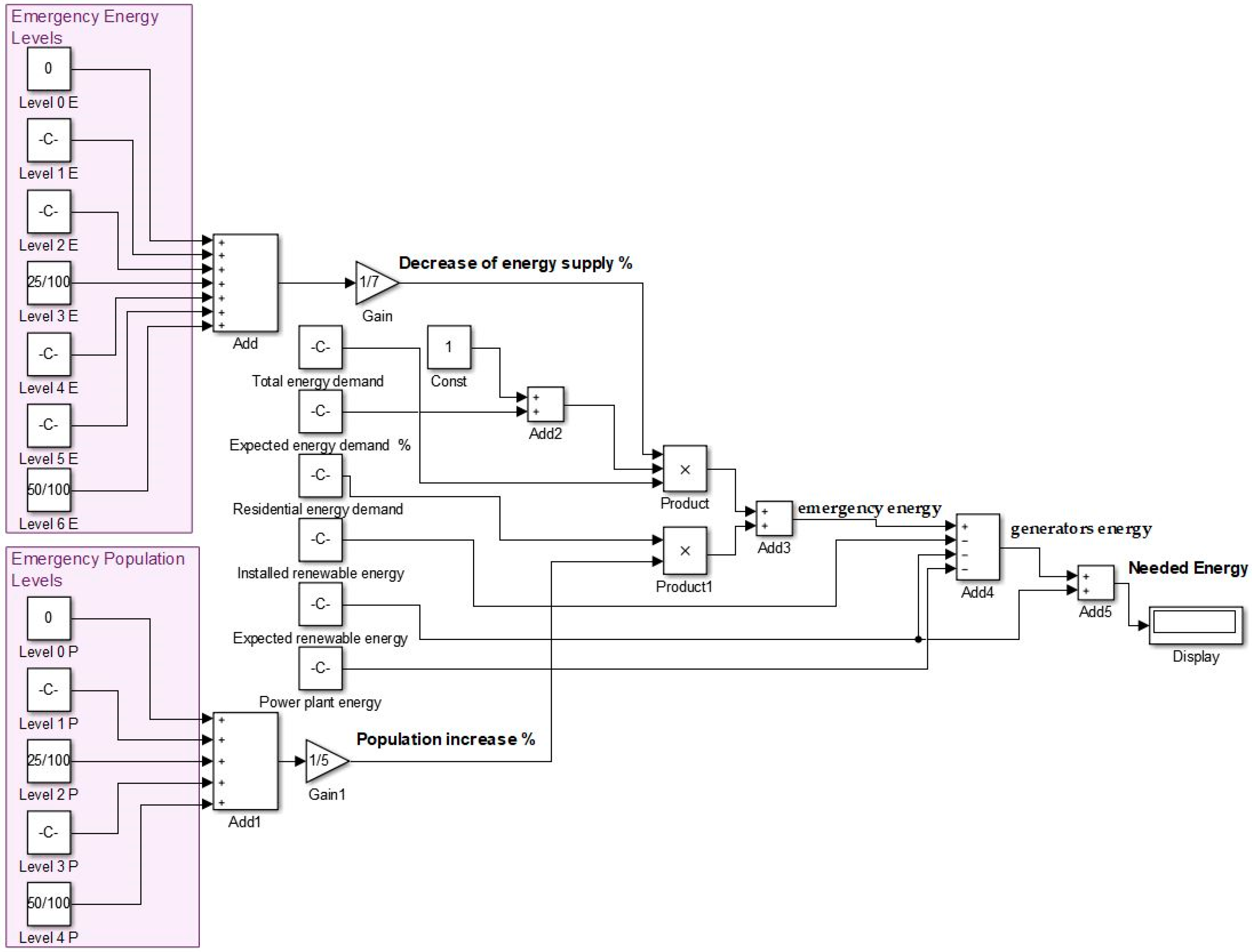
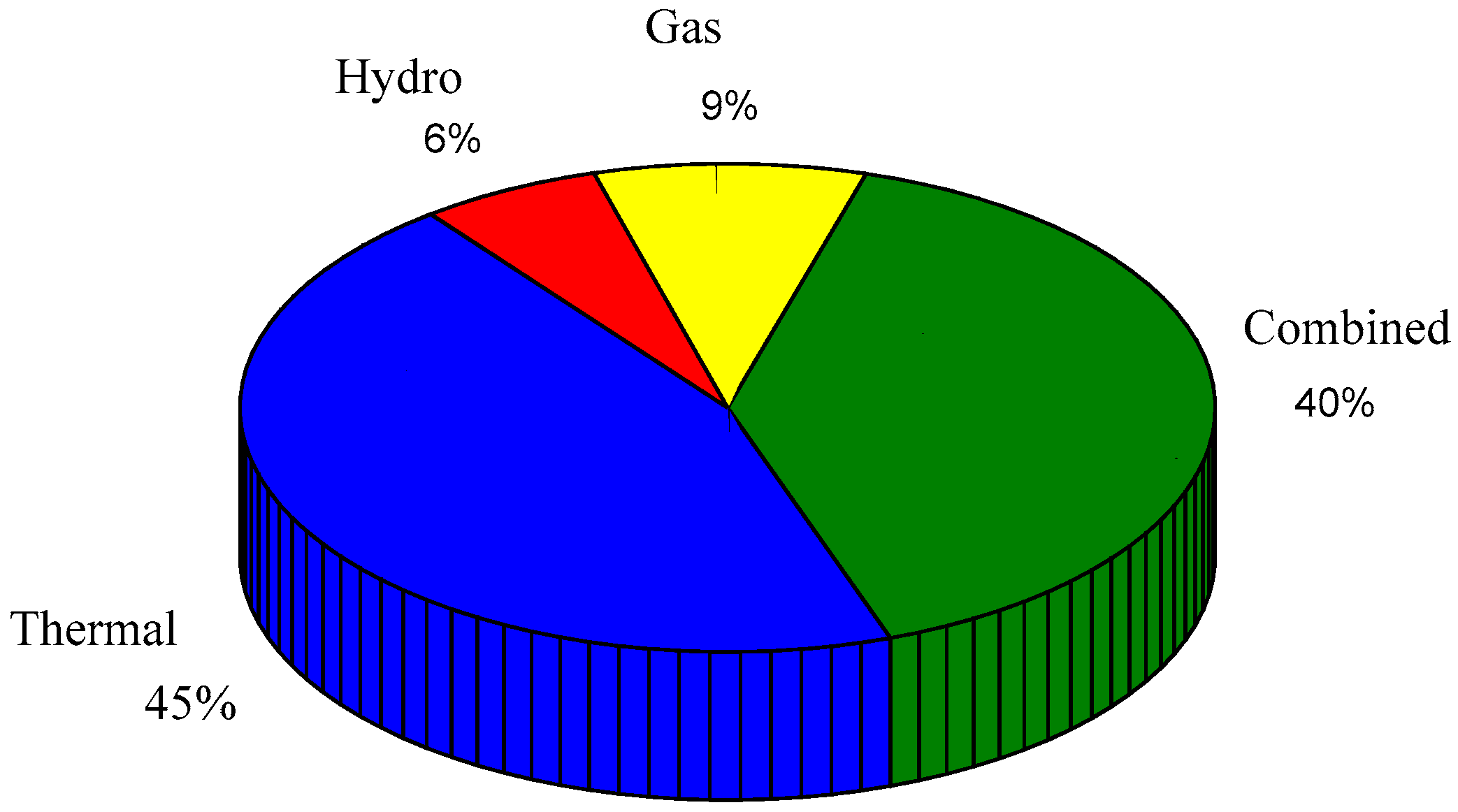


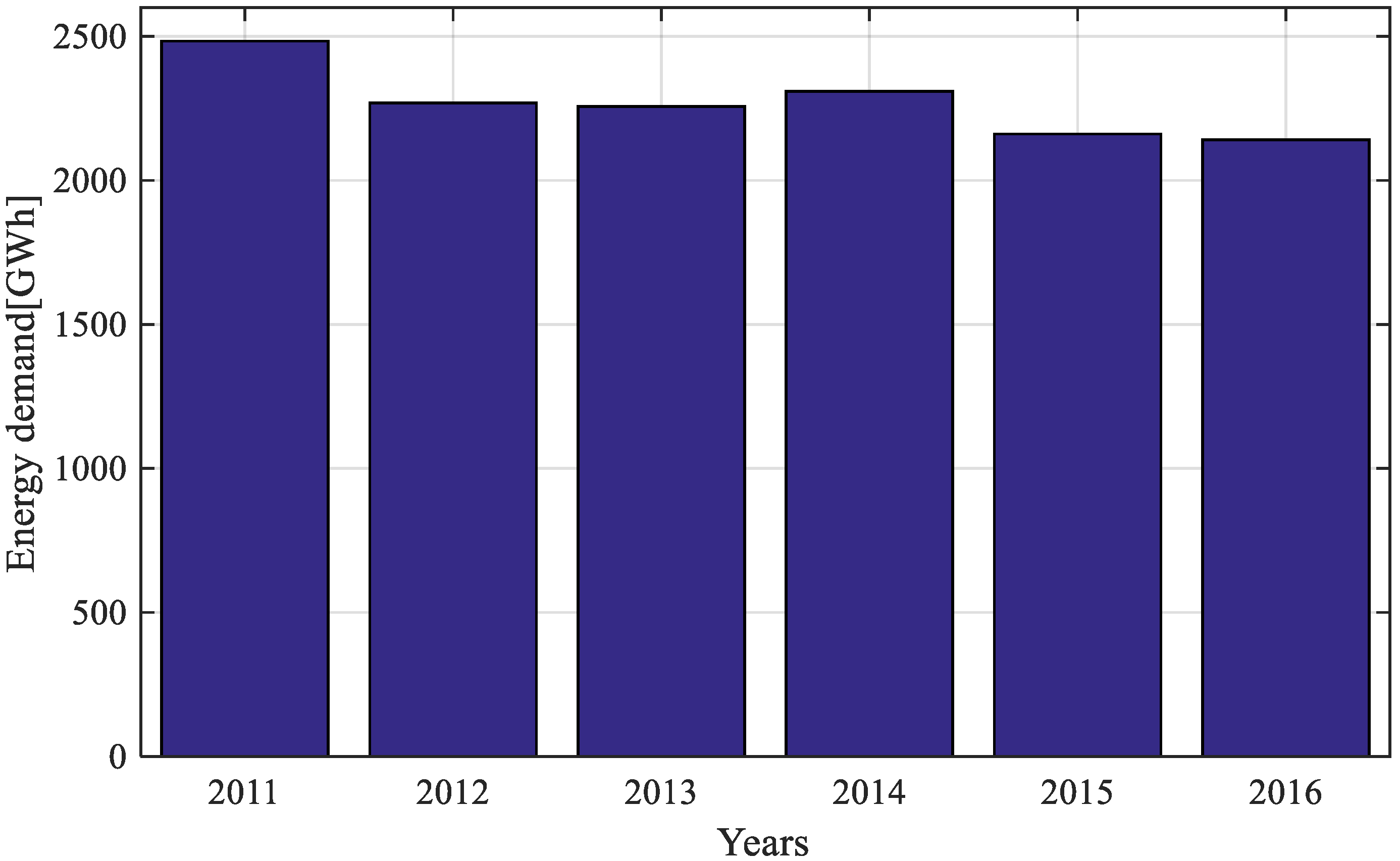
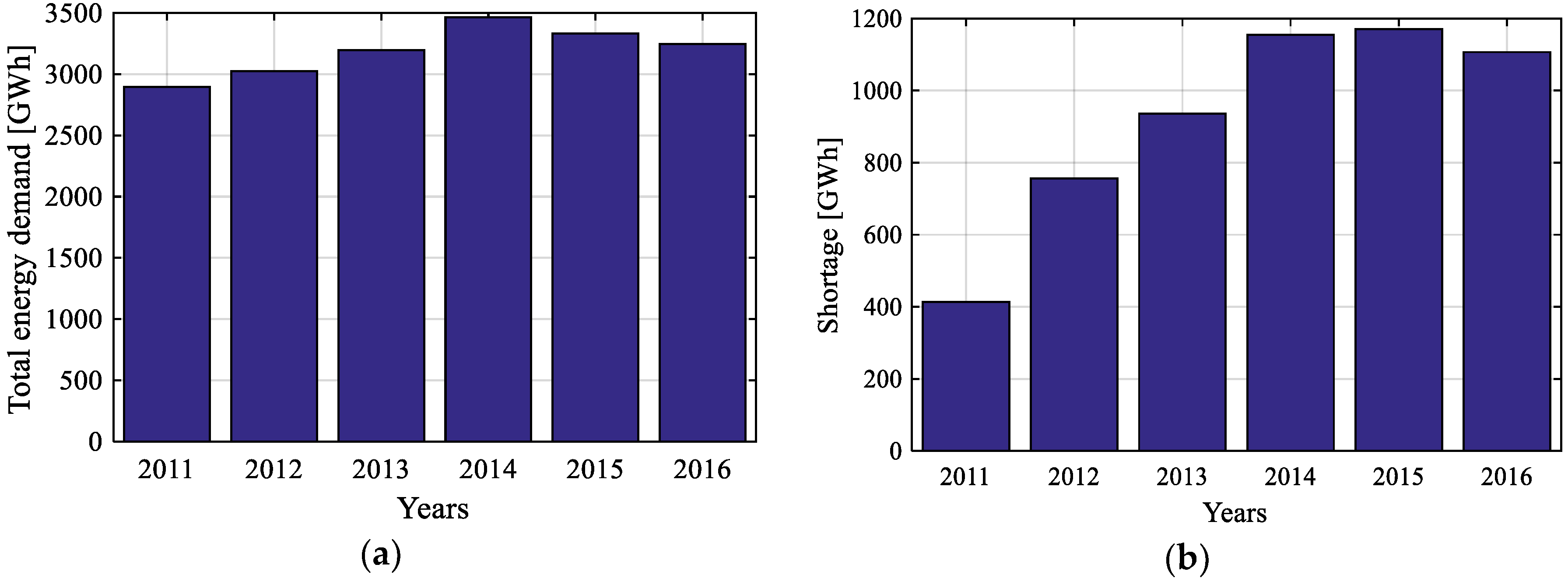
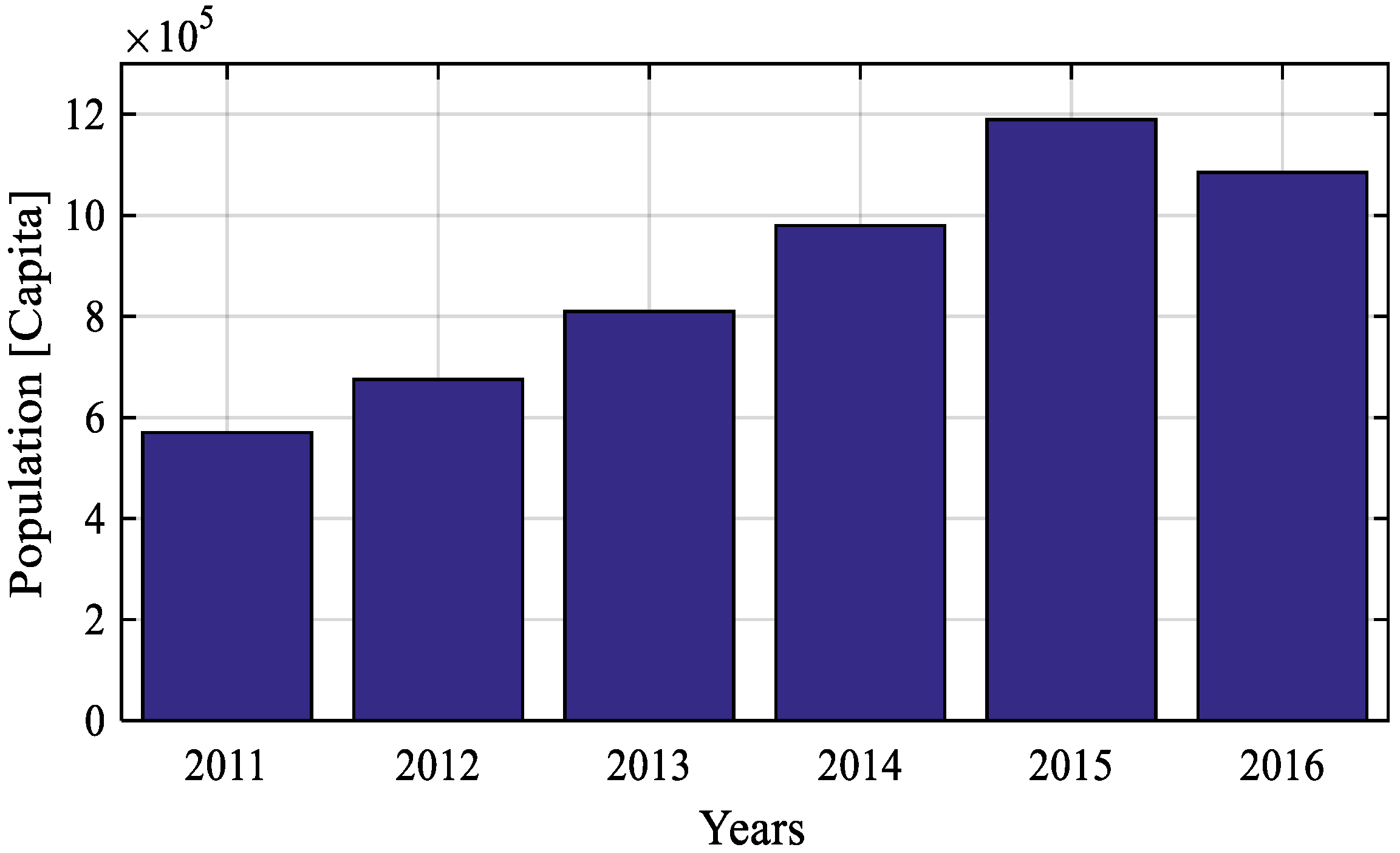
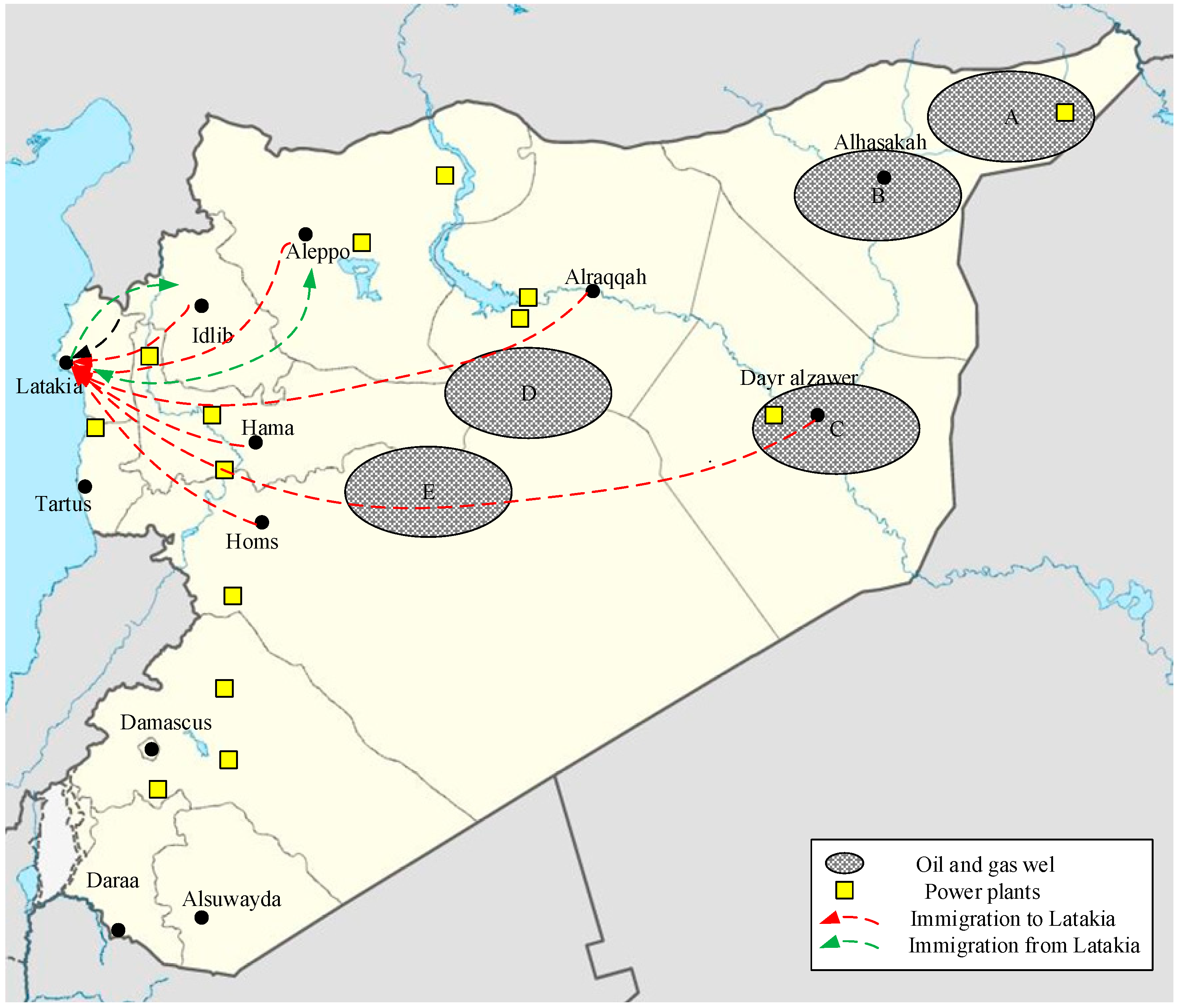
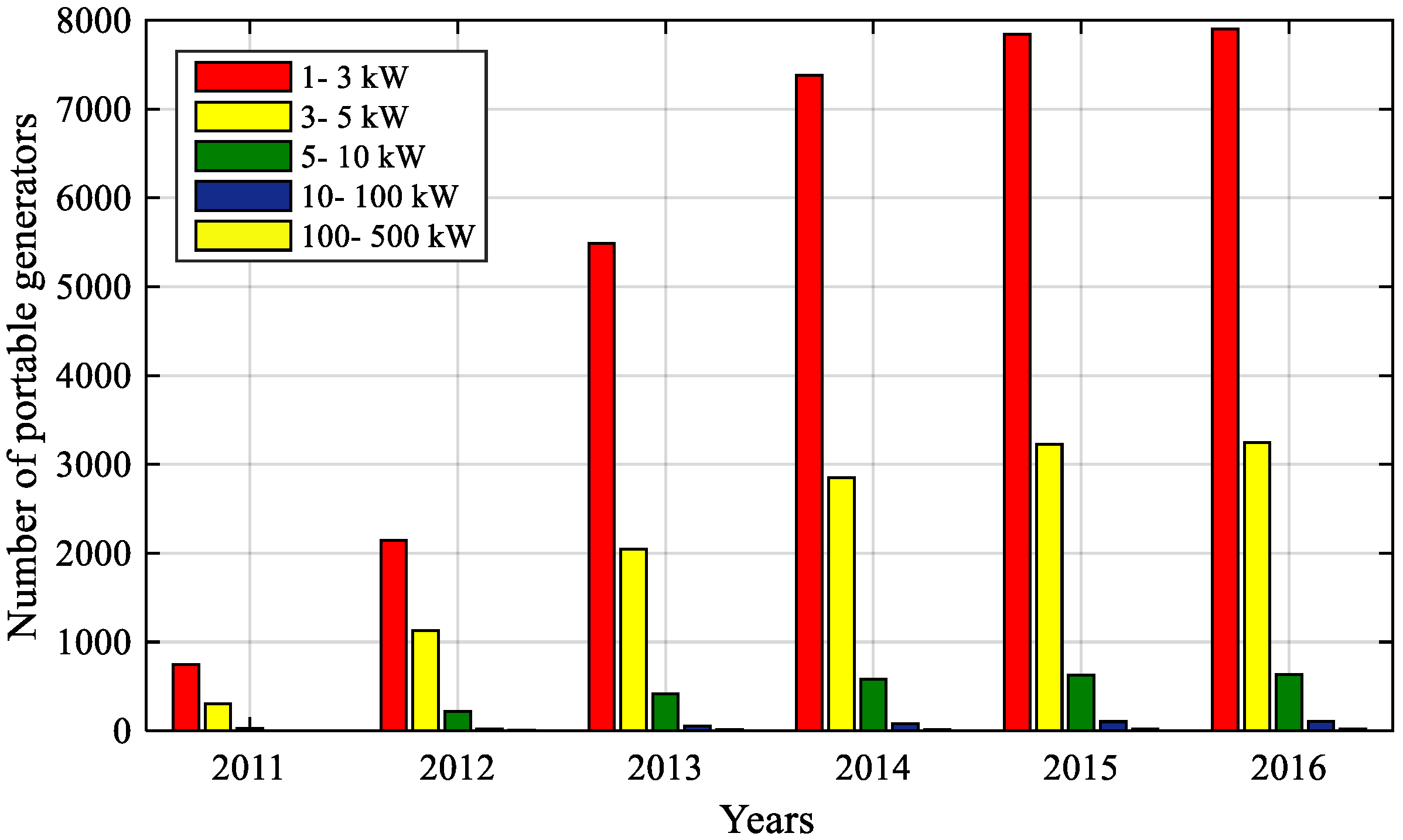

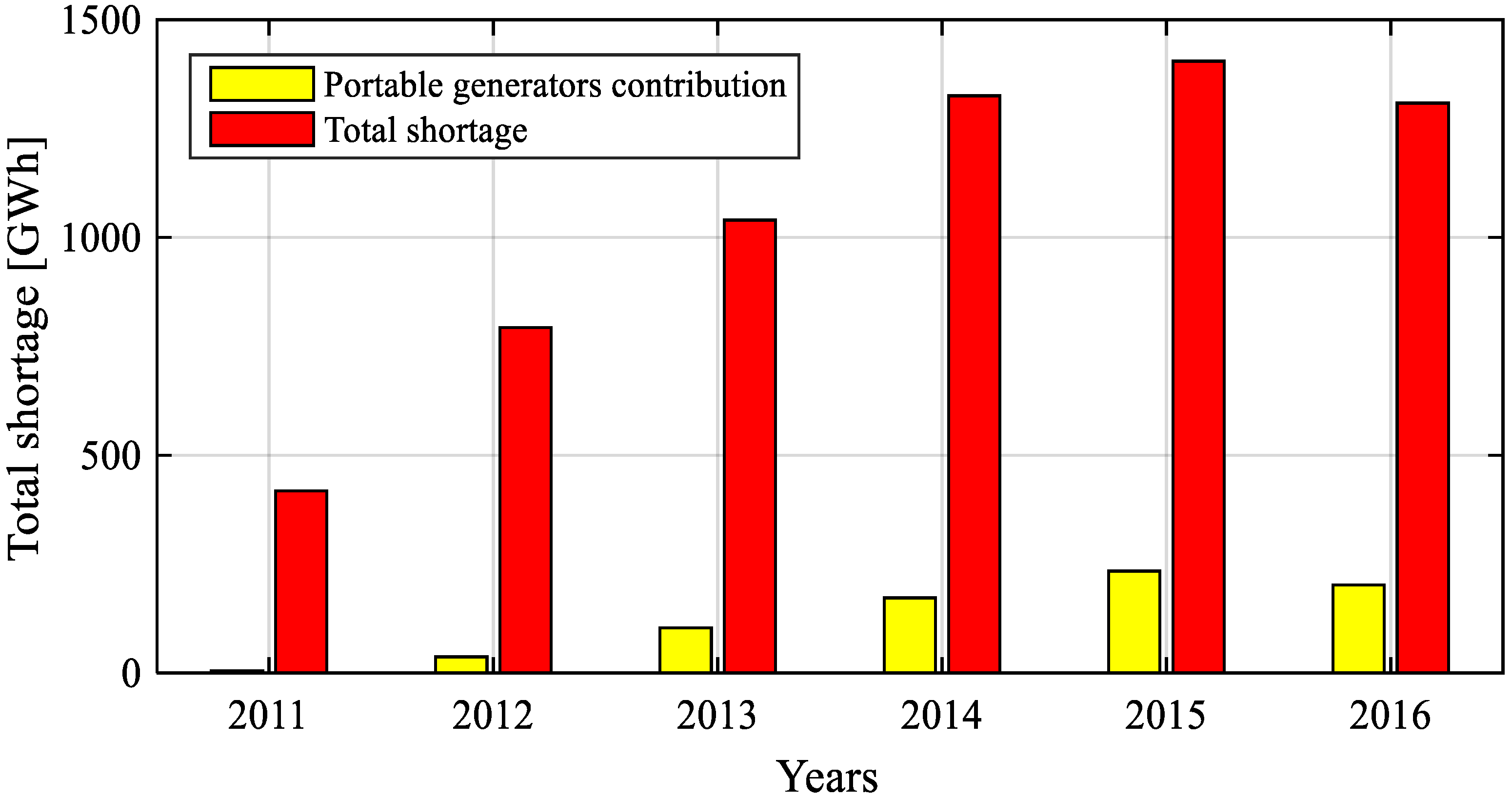

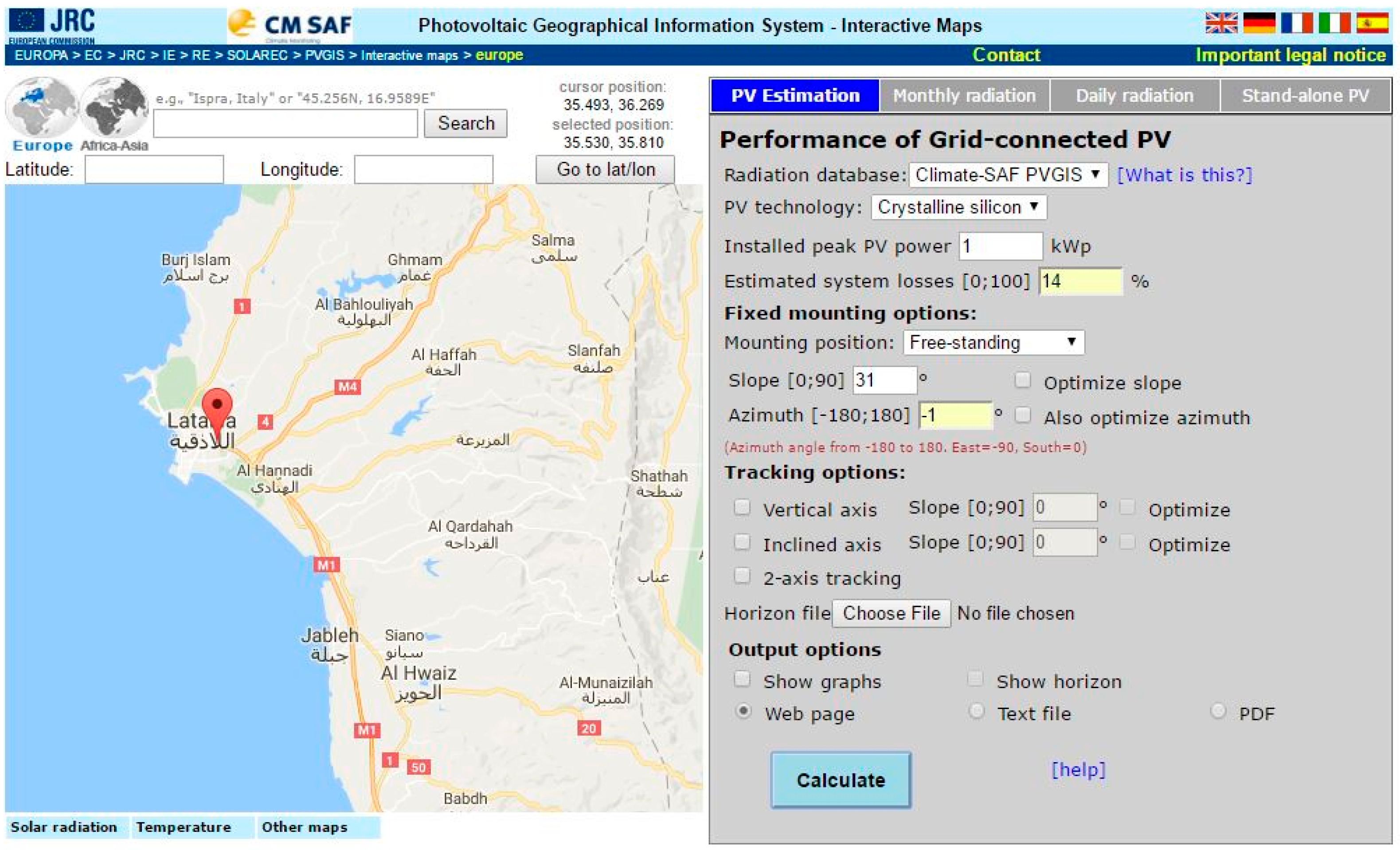
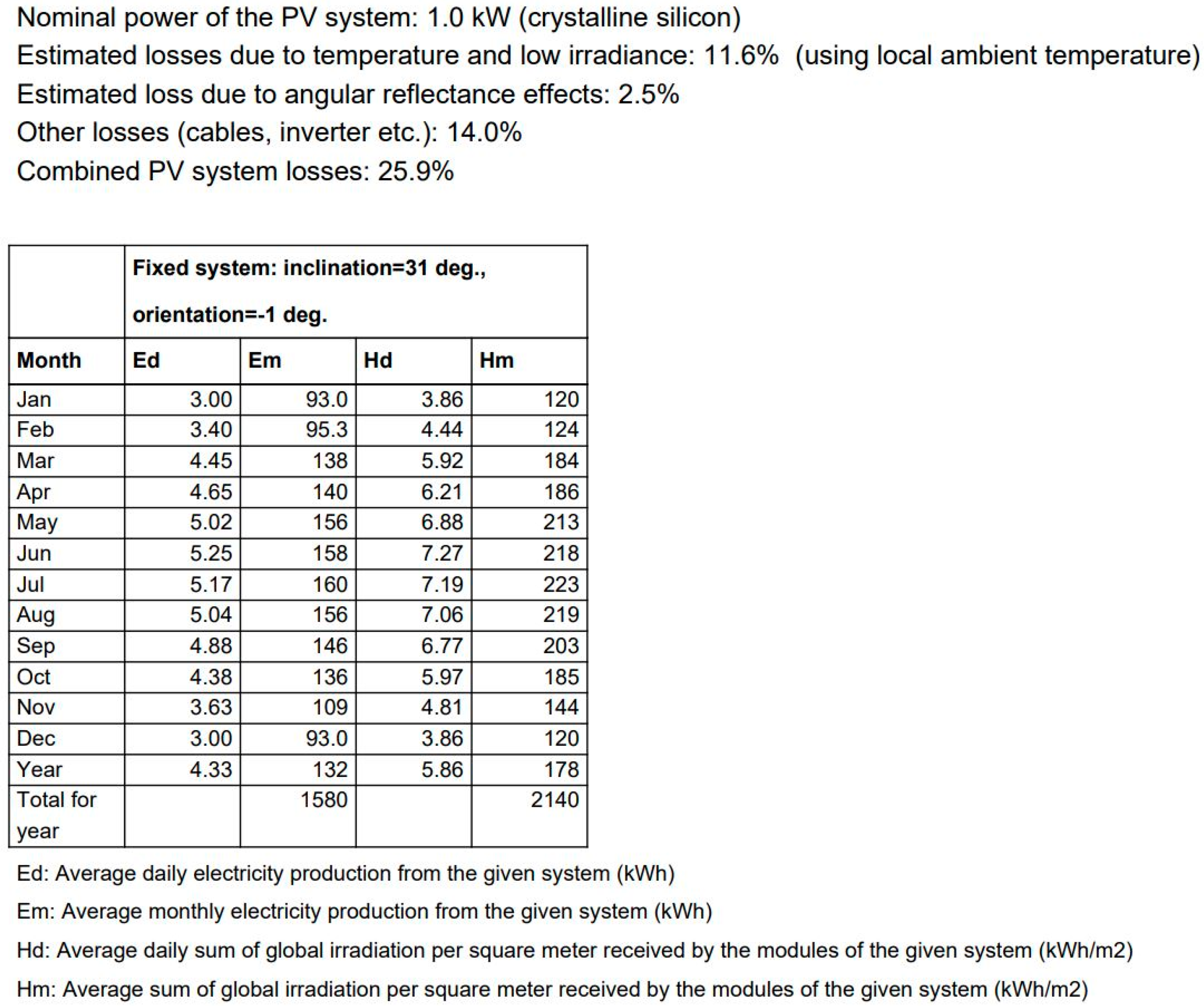

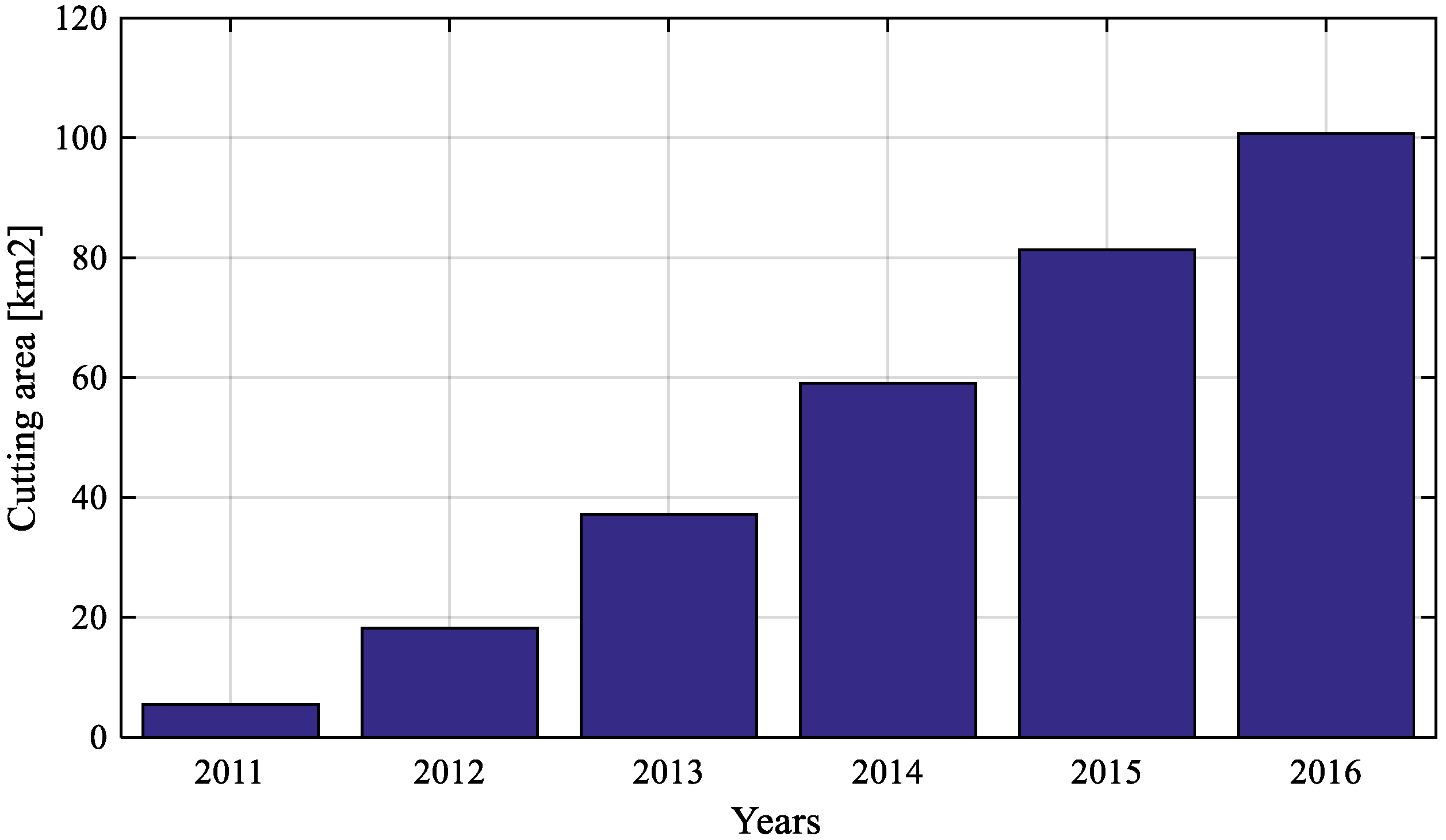
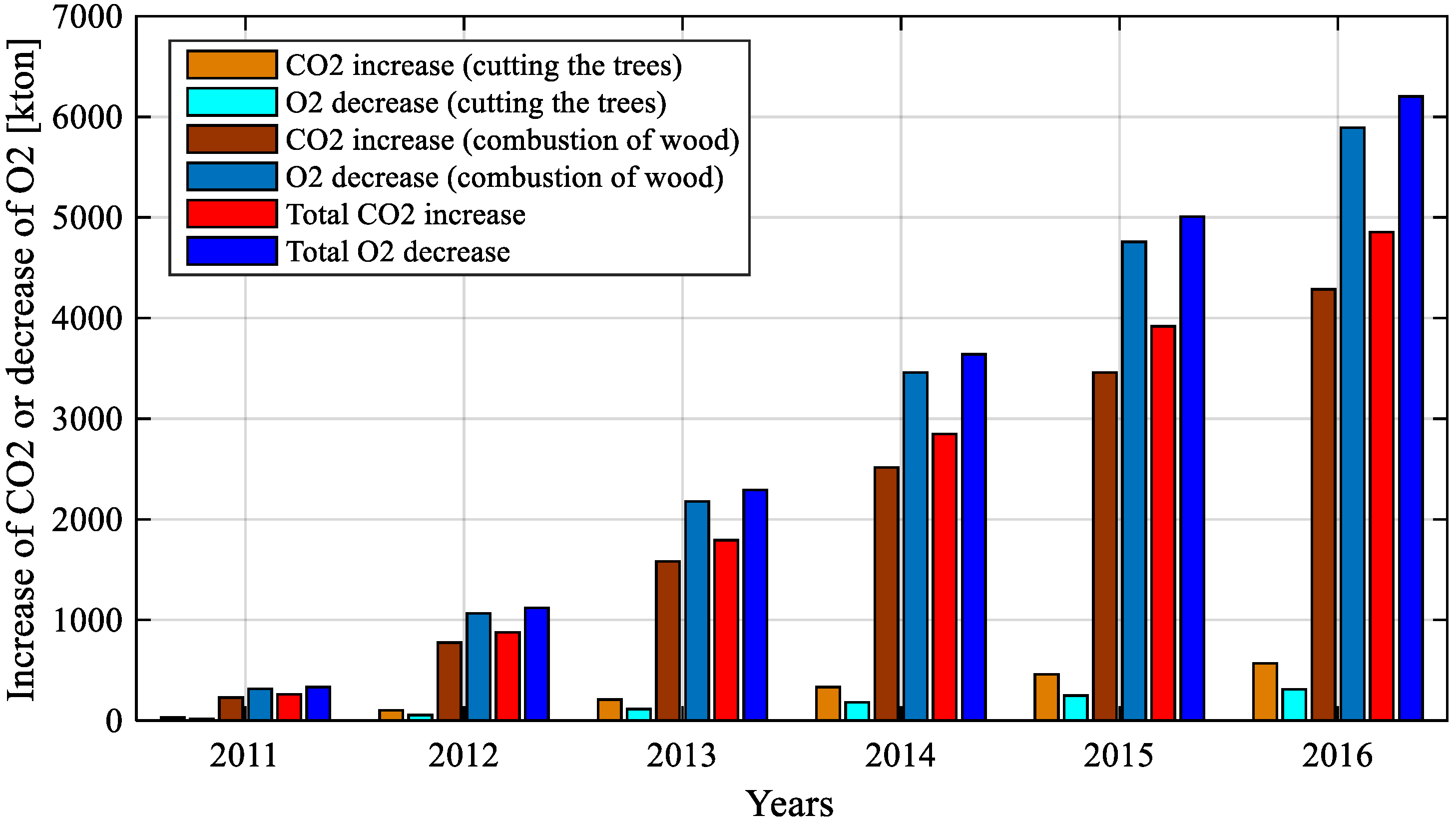

| Emergency Level | Cut Off Hours per Day |
|---|---|
| 1 | 2 |
| 2 | 4 |
| 3 | 6 |
| 4 | 8 |
| 5 | 10 |
| 6 | 12 |
| Emergency Level | Population Increase % |
|---|---|
| 1 | 12.5% |
| 2 | 25% |
| 3 | 37.5% |
| 4 | 50% |
| Year | Population | Change Percentage % | Cause of the Increase |
|---|---|---|---|
| 2011 | 570,000 | - | No migration |
| 2012 | 675,000 | 18.42% | Migration from Idlib, Hama and Homs |
| 2013 | 810,000 | 42.1% | Migration from Aleppo |
| 2014 | 980,000 | 71.93% | Migration from Aleppo and Latakia rural |
| 2015 | 1,190,000 | 108.77% | Migration from Aleppo and Latakia rural |
| 2016 | 1,085,000 | 90.35% | Going back to Aleppo and Homs |
| Buildings | Area (m2) |
|---|---|
| Schools | 54,000 |
| Faculties and university buildings | 21,600 |
| Government buildings | 23,100 |
| Residential buildings | 46,000 |
| Year | Rationing Hours (without Emergency System) | Rationing Hours (without Emergency System) |
|---|---|---|
| 2011 | 4 | 0 |
| 2012 | 8 | 0 |
| 2013 | 10 | 0 |
| 2014 | 12 | 48 min |
| 2015 | 14 | 1 h 40 min |
| 2016 | 12 | 40 min |
© 2018 by the authors. Licensee MDPI, Basel, Switzerland. This article is an open access article distributed under the terms and conditions of the Creative Commons Attribution (CC BY) license (http://creativecommons.org/licenses/by/4.0/).
Share and Cite
Fandi, G.; Krepl, V.; Ahmad, I.; Igbinovia, F.O.; Ivanova, T.; Fandie, S.; Muller, Z.; Tlusty, J. Design of an Emergency Energy System for a City Assisted by Renewable Energy, Case Study: Latakia, Syria. Energies 2018, 11, 3138. https://doi.org/10.3390/en11113138
Fandi G, Krepl V, Ahmad I, Igbinovia FO, Ivanova T, Fandie S, Muller Z, Tlusty J. Design of an Emergency Energy System for a City Assisted by Renewable Energy, Case Study: Latakia, Syria. Energies. 2018; 11(11):3138. https://doi.org/10.3390/en11113138
Chicago/Turabian StyleFandi, Ghaeth, Vladimír Krepl, Ibrahim Ahmad, Famous O. Igbinovia, Tatiana Ivanova, Soliman Fandie, Zdenek Muller, and Josef Tlusty. 2018. "Design of an Emergency Energy System for a City Assisted by Renewable Energy, Case Study: Latakia, Syria" Energies 11, no. 11: 3138. https://doi.org/10.3390/en11113138
APA StyleFandi, G., Krepl, V., Ahmad, I., Igbinovia, F. O., Ivanova, T., Fandie, S., Muller, Z., & Tlusty, J. (2018). Design of an Emergency Energy System for a City Assisted by Renewable Energy, Case Study: Latakia, Syria. Energies, 11(11), 3138. https://doi.org/10.3390/en11113138






